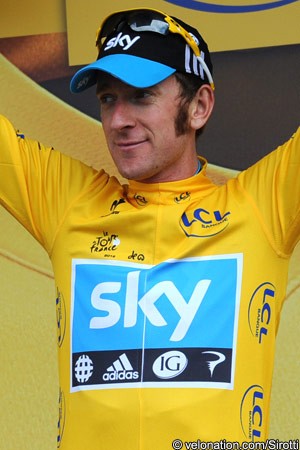Tour de France race leader puts the brakes on the peloton after tacks on the road threaten his rivals
 Stage 14 of the 2012 Tour de France saw controversy of a kind not seen since the early days of the race, as an estimated 30 punctures were caused by somebody throwing tacks onto the course. The incident occurred at the very top of the steep climb of the Mur de Péguère, with defending champion Cadel Evans (BMC Racing) the first high-profile victim of what currently appears to have been a prank, but the current possessor of the Maillot Jaune, Team Sky’s Bradley Wiggins, was determined that it would not cost the Australian his chance to challenge for this year’s race.
Stage 14 of the 2012 Tour de France saw controversy of a kind not seen since the early days of the race, as an estimated 30 punctures were caused by somebody throwing tacks onto the course. The incident occurred at the very top of the steep climb of the Mur de Péguère, with defending champion Cadel Evans (BMC Racing) the first high-profile victim of what currently appears to have been a prank, but the current possessor of the Maillot Jaune, Team Sky’s Bradley Wiggins, was determined that it would not cost the Australian his chance to challenge for this year’s race.
As soon as it was clear that multiple rider’s were suffering punctures, Wiggins neutralised the front group of the peloton, which meant that riders like Evans were able to rejoin.
“I didn’t see a lot out on the road really,” Wiggins explained afterwards. “I just heard that there were so many flats in a couple of seconds. I wasn’t aware of it until it happened. No one wants to benefit from someone else’s misfortune so I think we should decide this thing on the climbs, through racing and not through other people’s misfortune.
“I don’t know what happened,” he added. “People who watched it on television probably know more than me.”
As well as the estimated 30 riders, five race motorcycles and a number of cars also suffered punctures, which affected TV coverage of the stage as the French director struggled to keep his cameras up with parts of the race. Carpet tacks were found on the course by race officials, but for Wiggins – in the race, at the time – things were less clear, but it was clear to him what he should do.
“I heard rumours that there were thumb tacks on the road,” he said. “It’s unfortunate that something external to the racing is affecting the racing. It’s quite sad really.
“Everybody sees those situations differently but personally I wouldn’t want to benefit from something like that,” Wiggins explained. “I thought the best thing to do is to wait. If you can’t gain times on the climbs, then you don’t do it when someone’s punctured – not even when it’s an ordinary puncture… so when it was something like what happened today, something external affecting the race, then it’s even more so.”
Although he was not fully aware of the cause of all the punctures, with the stage obviously to be decided by the eleven-man group up the road, there seemed to be little harm to Wiggins’ own position if the peloton slowed down. With the descent to the finish much wider, gentler, and straighter than the road that they had just come up, it was also highly unlikely that the Briton would have come under attack – notwithstanding the initial jump from Europcar’s Pierre Rolland – from the more fearless descenders among his rivals.
“There were so many punctures at once that it was obvious that something had happened,” he said. “We went up the climb hard. Nothing happened. And obviously it seems logical to wait; we were 17 minutes behind the breakaway… when everyone punctured at once it made sense to ride easy for a couple of kilometres so everybody could get their wheels changed. The climb was so narrow that the team cars were a long way back and waiting seemed the honourable thing to do.
“No one wants to see something like that have an impact on the race,” he re-emphasised. “As a group the thing to do was to wait. The stage win was over. The climb was over. There was nothing left to contest really…”